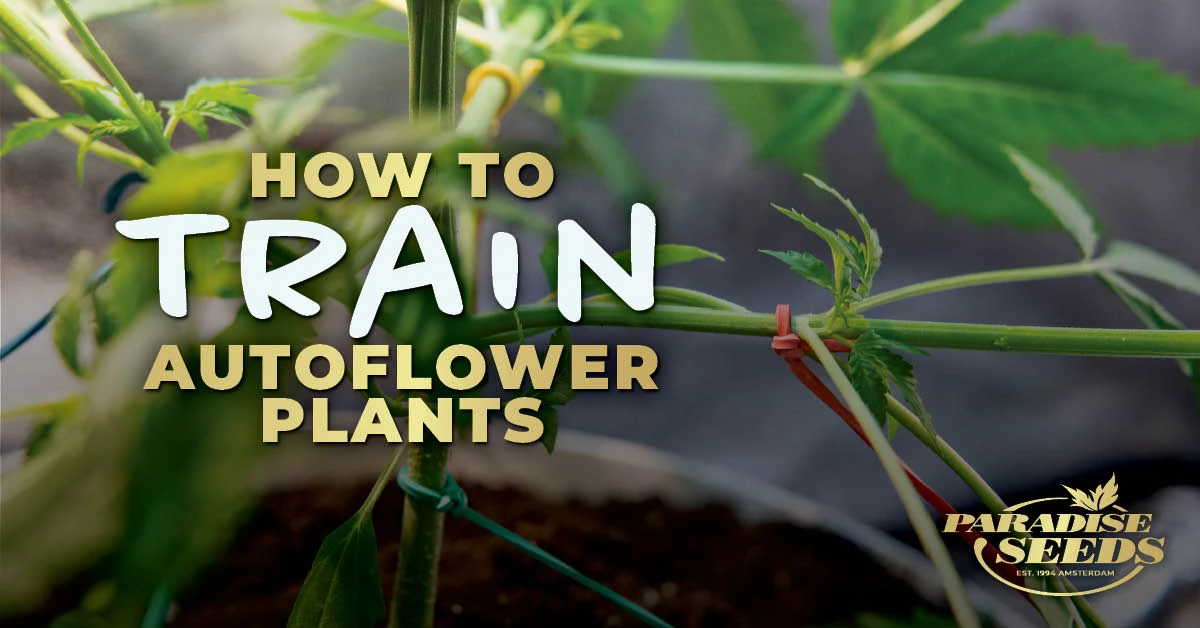How to train autoflower weed plants is a question frequently asked by growers who are seeking to increase the yields of these fast flowering varieties. It’s a good question because one of the common lines of thought associated with autos is that training should be avoided exactly because of their fast growth cannabis plant cycle. This thinking says that training will stress the plants out too much.
As a result this has become a common myth which many growers toss out as ’fact’ without actually researching the facts! There is of course some truth to the statement as the short growth cycle (automatically flowering after around 25 – 30 days) does indeed make them more vulnerable to stress, but you just need to be careful about choosing the right method. For this reason you can use LST to train autoflower weed plants.
How to train autoflower weed plants with the LST training method
Knowing how to train weed is useful knowledge for every grower. As the name suggests, LST cannabis training involves manipulating weed plants as they grow but in a very gentle way. The idea is to encourage horizontal growth and even bud development over the canopy by opening up more bud sites to the light. You can read our comprehensive LST explainer guide in the Grow Tips section of our blog.
What tools do you need to train autoflower weed plants using the LST technique?
It’s easy to learn how to train autoflower weed strains using LST. Aside from autoflower weed seeds you will need a couple of simple tools to help with the job. If you are growing in a pot, then it is advised to drill some holes in the rim in order to provide anchor points for tying branches. Kebab skewers and U—shaped garden stakes are basic scaffolding tools while soft tie garden wire (sturdy but bendy) is used for tying down branches.
How do you use LST with autoflower weed plants?
Before we take a closer look at using LST to train autoflower cannabis plants, it’s important to appreciate the difference between photoperiod plants and autos. The main variance, which influences how you treat them, is the time factor. Autos take just over 3 months from seed planting to harvest outdoors (compare this to 5 – 6 months for most photoperiod plants).
Therefore each one of the first 20 days is significant in the life of an auto plant. The aim should be to give it optimum conditions to grow as quickly and healthily as possible (our How to Make the Most from Cannabis Autos blog provides some essential tips.
LST training for autoflower weed plants explained
At around 25 – 30 days, the LST process begins as by now the side branches should be long enough to bend and train. Some growers who use LST with autos will top the plants to encourage bushier growth in this period, but we don’t recommend this as it may be a stress point as the auto starts flowering.
Which branches get tied down using LST training?
The obvious answer to this is to go from the top! However, there is an element of intuition to the process, depending on how the plant is growing. Radiating from the centre of the pot, the goal is to extend the branches like spokes on a bicycle wheel towards the edges of the pot. Ultimately, a LST auto plant should look a little like an upside down umbrella, with buds extending from a nice open structure.
What’s the best method for tying down auto branches using LST?
Every LST training guide will put an emphasis on ‘gentle’ handling and it is no different if you train autoflower marijuana plants. The process of tying down branches and encouraging horizontal growth begins by bending the main branches towards the floor and anchoring them down (peg down close to the base of the side branch and behind its first node). U-shaped garden pegs are perfect for holding them in place but garden wire bridged between two kebab skewers also works fine.
An advanced LST training guide tip is to tie down lower branches to form one level and manipulate the upper level so that the branches occupy their own space (again picture the bicycle spokes) and therefore are not depriving the lower branches of light. To do this, lightly work the top of the main stem back and forth between the fingers until it becomes more flexible, then gently turn the main stem to a position where the side branches can be tied down into their own space ie this branch is not shading out the one below. It takes gentle handling and confidence, so if you lack either, avoid this tip!
How often do you retrain the branches?
The initial ‘tie down’ is completed as part of the train autoflower process before the plants start their stretch phase. They will look untidy to begin with but this will change as the branches stretch out and the shape of the structure becomes more obvious. A rule of thumb should be to change the ties and anchor points every 5 – 7 days. As it grows the plant will outgrow its pegs, so the soft garden wire (attached to the pegs or those drilled holes in the pot edge) will become the main means to hold branches in place.
It really is that simple! No cutting or chopping or extreme training make overs… just gentle, consistent encouragement for the plant to extend its branches and develop those flower sites, resulting in more buds and bigger harvests. It’s easy!
Summary and recommended autoflower weed seeds
LST is a great technique to use to train autoflower weed plants because of its low impact. There are no best autoflower weed seeds for LST training because the results are achieved through the technique alone. Nevertheless the best autoflower weed seeds to use are those which come from a reliable source, such as Paradise Seeds, which has an in-house breeding program and therefore offers a guarantee of quality. The best plants begin with healthy seeds!


